MR-Guided Interventions
Traditional Poster
Interventional MRI
Monday, 18 June 2018
| Exhibition Hall 1476-1508 |
13:45 - 15:45 |
|
1476.
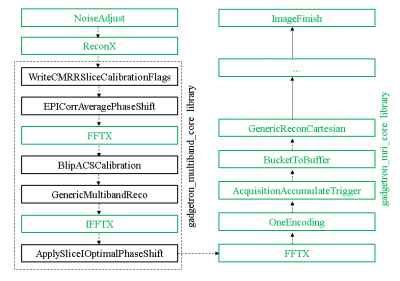 |
Evaluation of 2D simultaneous multi-slice EPI for high resolution thermometry in the brain at 3T.
Valéry Ozenne, Pierre Bour, Mathieu Santin, Romain Valabrègue, Charlotte Constans, Aurélien Trotier, Sylvain Miraux, Jean-Francois Aubry, Bruno Quesson
MR-guided HIFU in the brain currently lacks from insufficient spatial and temporal monitoring of the effect of ultrasound. In this study, we combine simultaneous multi-slice (SMS) echo planar imaging (EPI) technique with in-plane parallel imaging to achieve high spatial resolution with large volume coverage and/or short acquisition time during temperature mapping at 3T. The sequence was tested in vivo in a human brain with different multiband (MB) factors. SMS reconstruction and temperature mapping were computed using the Gadgetron framework. Then, validation was performed on an ex vivo chicken muscle during HIFU sonication to validate the method.
|
|
1477.
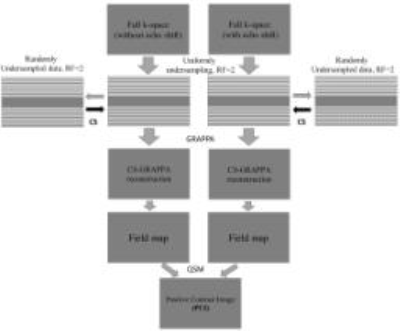 |
Accelerated imaging for visualizing interventional devices using parallel acquisition and compressed sensing reconstruction
Samira Vafay Eslahi, Caiyun Shi, Haifeng Wang, Yifeng Ye, Hanwei Chen, Guoxi Xie, Jim Ji
Visualizing implanted and/or surgical devices is crucial for interventional radiology. Conventional MRI shows the devices as dark voids or with metal artifacts. Recent methods based on susceptibility mapping using fast spin-echo sequences can offer positive contrast visualizations, but they are relatively slow. In this work, parallel acquisition and compressed sensing reconstruction are integrated to accelerate the phase-sensitive acquisition and reconstruction. Applications in brachytherapy, biopsy and stent placement are demonstrated with simulations from real data. The proposed method can increase the acquisition speed by four while preserving the images quality.
|
|
1478.
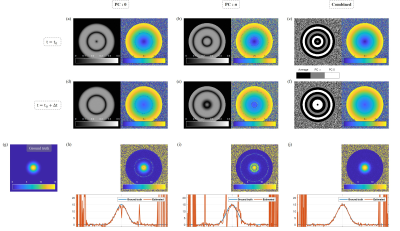 |
Proton resonance frequency based MR thermometry using shifted-echo bSSFP
Seohee So, Jaejin Cho, Kinam Kwon, Byungjai Kim, Wonil Lee, Hyunwook Park
Magnetic resonance thermometry provides noninvasive temperature measurements for thermal therapy. In this abstract, we exploit linear phase relation generated by echo shifting in the bSSFP acquisition to measure PRF change. Echo-shifting from TE=TR/2 in bSSFP provides a linear relation between phase of transverse magnetization and phase evolution in TR. This linearity enables frequency prediction from the phase information, which makes temperature measurement with PRF shift possible. The performed simulations show shifted-echo bSSFP of TE=TR/4 well estimates frequency change.
|
|
1479.
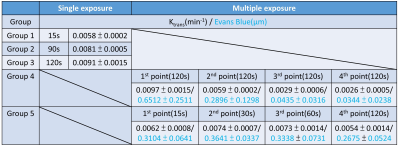 |
Dependence of Focused-Ultrasound Induced Blood-Brain Barrier Opening Effect with Exposure Time: Evaluation via Dynamic Contrast-Enhanced Magnetic-Resonance Imaging
Wen-Yen Chai, Po-Chun Chun, Sheng-Kai Wu, Chih-Hung Tsai, Hsin-Yi Lai, Hao-Li Liu
FUS exposure with presence of microbubbles can transiently open the BBB at targeted brain tissues. The study purpose is to investigate the dependency of the BBB opening effect with ultrasound exposure time by DCE-MRI. Our result showed extending exposure time can effectively increase FUS-induced BBB opening degree without causing tissue damage. We also proposed a strategy by adjusting exposure time during the multiple exposures to overcome the effects that microbubbles concentration dynamic changed after IV bolus injection. This approach of control FUS exposure time may bring technology advances of FUS-induced BBB opening to deliver drug for CNS disease treatment.
|
|
1480.
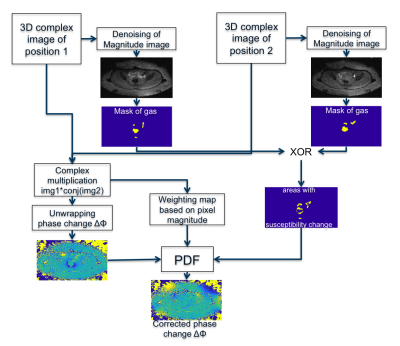 |
Correction of Motion-Induced Artifacts in PRFS MR Thermometry During Mild Hyperthermia in the Pelvis
Mingming Wu, Paul Baron, Hendrik Mulder, Eduardo Coello, Marion Menzel, Gerard Van Rhoon, Axel Haase
Digestive motion including gas is the predominant source of artifacts for PRFS MR Thermometry monitored RF hyperthermia inside the pelvis. Gastrointestinal motion of gas introduces large field variations inside the pelvis, thus significantly hampers PRFS based MR temperature reading. The estimation of these dipolar field disturbances from a changing susceptibility distribution is very exact in case we know the mask of Δχ, as shown with a phantom experiment. But using the PDF method, which allows a heterogeneous distribution of Δχ-values in the background, the temperature error could be reduced to noise level for in-vivo data in presence of susceptibility artefacts as well.
|
|
1481.
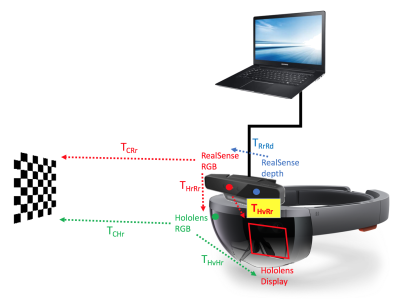 |
Marker-less co-registration of MRI data to a subject’s head via a mixed reality device
Christoph Leuze, Grant Yang, Gordon Wetzstein, Mahendra Bhati, Amit Etkin, Jennifer McNab
Many medical applications such as brain surgery or stimulation require the clinician to identify an internal target location. Mixed reality see-through displays that enable a holographic visualization of brain MRI superimposed on a subject’s head can help clinicians identify internal target locations but require tracking methods that keep the holographic brain MRI aligned with the subject’s head as they move. We present a method for marker-less tracking of a subject’s using a depth-sensing camera, which tracks facial features and sends location and rotation information to a see-through display to update the location in space of the MRI holograms.
|
|
1482.
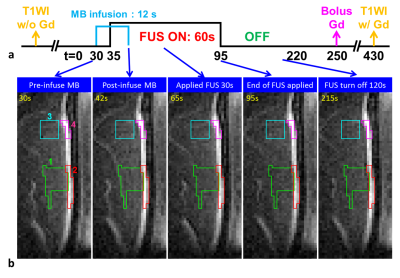 |
Inertial Cavitation Induced Magnetic Resonance Signal Changes in a Rat Model
Cheng-Tao Ho, Chen-Hua Wu, Po-Hung Hsu, Hao-Li Liu, Chih-Kuang Yeh, Ching-Hsiang Fan, Wen-Shiang Chen, Hsu-Hsia Peng
We aim to real-time monitor the inertial cavitation (IC)-induced signal intensity (SI) changes in the presence of microbubbles and explore the correlation between the extent of IC-induced SI changes and the location of blood–brain barrier opening in a rat model. The computed |slope| map illustrated the territory of tissue with substantial SI changes and was consistent with the difference map (calculated from T1WI with and without Gd) and Evens Blue dyed region. In conclusion, we verified the feasibility of using FLASH sequence to distinguish the location of BBB-opening through the computed |slope| map in a rat model.
|
|
1483.
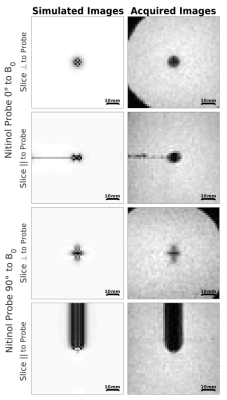 |
MR imaging simulator and optimized multi-echo z-shimmed sequence for temperature mapping near metallic ablation probes
Megan Poorman, Yue Chen, Robert Webster III, Eric Barth, William Grissom
Signal loss near metallic ablation probes can prevent quality MR thermometry guidance of treatment. Previously we proposed an orientation-independent multi-echo Z-shimmed sequence that could recover the lost signal and improve temperature precision near the probe. However, this method was not feasible for online implementation due to the need to acquire high resolution off-resonance maps around the ablator followed by a computationally-intensive optimization. Here we present an MR imaging simulator that calculates images near metallic ablation probes and successfully use it for offline optimization of the multi-echo Z-shimmed pulse sequence.
|
|
1484.
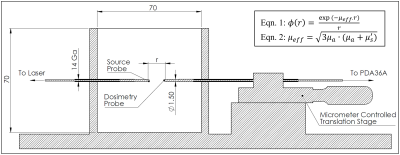 |
Development of a Tissue Mimicking Phantom for Focal Laser Ablation of the Prostate
Rory Geoghegan, Alan Priester, Alvaro Santamaria, Le Zhang, Samantha Mikaiel, Holden Wu, Warren Grundfest, Leonard Marks, Shyam Natarajan
There is a need to further develop real-time feedback systems for monitoring focal laser ablation (FLA). Here we have developed a tissue mimicking phantom to facilitate research on the use of magnetic resonance thermometry (MRT) and interstitial thermal probes as feedback systems. The tissue mimicking phantom was designed to match the optical and thermal properties of prostatic tissue at 980nm. The thermal response of the phantom to FLA was then compared to previously acquired clinical data and found to be qualitatively and quantitively similar to prostatic tissue. MRT and real-time quantification of damage zone progression are also demonstrated.
|
|
1485.
 |
Monitoring and Guidance on High-Intensity Focused Ultrasound Treatment by Multiple Fast Field Echo at 3.0 T MRI: Ex-Vivo Studies with Multiparametric Mapping
Jong-Min Kim, Chulhyun Lee, Young-Seung Jo, Han-Jae Chung, Seong-Dae Hong, You-Jin Jeong, Jeong-Hee Kim, Chang-Hyun Oh
Because the multiple Fast Field Echo (mFFE) is rich in contrast manipulation, such as, in water-fat, susceptibility, conductivity, and temperature imaging, it is well suited to guide the thermal treatment. In this study, we sought to investigate the feasibility of the mFFE for monitoring and guidance of HIFU treatment in ex-vivo swine tissue. To demonstrate this study, we present the conductivity, temperature, and susceptibility mapping results. We have shown that the mFFE is very useful for guidance and monitoring of the HIFU treatment. Simultaneous temperature, conductivity, and susceptibility mapping has
been tried using the mFFE sequence and its utility has been shown in this paper.
|
|
1486.
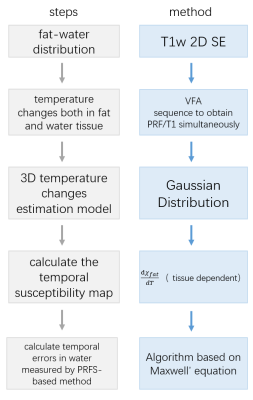 |
Temperature Induced Susceptibility Correlation in Adipose Tissues for MR-Guided Microwave Ablation
Yongyu Lin, Kexin Deng, Jinchao Wu, Bingyao Chen, Jiafei Yang, Xing Wei, Kui Ying
Microwave ablation requires high temperature measurement accuracy to monitor the curative effect of the lesions. PRFS-based MR thermometry is the most commonly used temperature monitoring technique. However, PRFS is hampered by temperature-dependent magnetic susceptibility changes. It has been proved in the Quantitative Susceptibility Mapping(QSM) that susceptibility can be measured from the phase changes ,which is derived from Maxwell’s Equation. In this work, we proposed a practical method to calculate the errors caused by temperature-induced susceptibility changes based on the method in QSM. Both Simulation studies and microwave heating experiments validated the accuracy of the method.
|
|
1487.
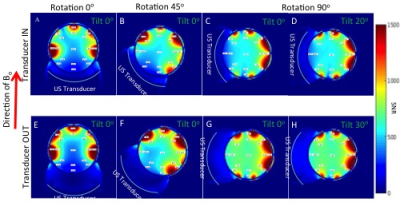 |
The effect of transducer position on signal-to-noise ratio in magnetic resonance guided focused ultrasound
Emilee Minalga, Robb Merrill, Dennis Parker, Allison Payne, J. Hadley
Hardware requirements can be a roadblock to implementing procedure-specific coils in magnetic resonance guided focused ultrasound. In order to more effectively implement coils in the system, the effects of the focused ultrasound transducer’s position on SNR needs to be considered. This work characterizes the SNR and noise correlation variability of the RF coils by evaluating the SNR tradeoffs and noise correlation as a function of device orientation and transducer position and report such variances. Understanding the SNR tradeoffs of system placement during treatment can aid in increased SNR within the treatment volume and can be a factor to consider in treatment planning.
|
|
1488.
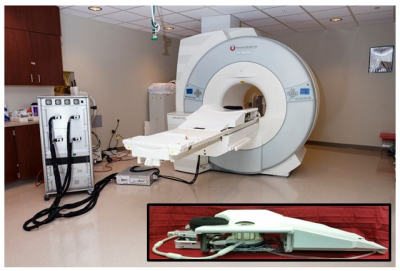 |
A hardware and algorithm framework for focal spot and slice positioning in MRgFUS treatments
Robb Merrill, J Hadley, Katelynn Stroth, Dylan Palomino, Dennis Parker, Allison Payne
MRgFUS systems can be designed with a high degree of transducer positioning variability for precise focal point placement during tissue ablation procedures. This study evaluates hardware design and complementary algorithmic adaptations that predict the focal spot location and MRI slice orientation as a function of transducer adjustment settings. These design features were evaluated by comparing the physical focus of a mock transducer to the computed focus location from the prediction algorithm. The mean error between the measured and predicted point position was found to be 2.9±1.8mm (N=20). Predicted slice orientation parameters also showed good agreement with hardware adjustment measurements.
|
|
1489.
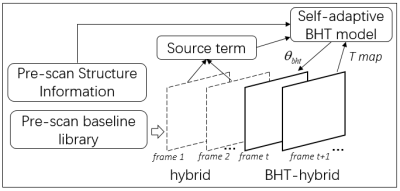 |
Self-adaptive Bio-heat Transfer Model Modified Hybrid for Monitoring Temperature in Microwave Therapies
Jinchao Wu, Shihan Qiu, Bingyao Chen, Jiafei Yang, Xing Wei, Kui Ying
A BHT model was introduced to modify the penalty term of hybrid method for monitoring microwave ablation. Simulation results demonstrate that the proposed method is robust with the BHT model and can reconstruct more accurate temperature maps with different regularization parameters. Ex vivo experiment shows that the proposed method can achieve improved performance for rapid background shifting.
|
|
1490.
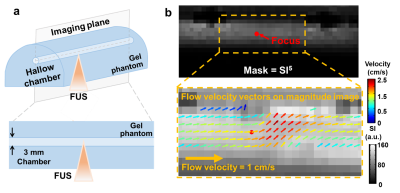 |
Detection of Acoustic Radiation Force-Induced Aggregated Bubbles by Velocity and Vorticity Maps
Che-Wei Wu, Po-Hung Hsu, Hao-Li Liu, Chen-Hua Wu, Ching-Hsiang Fan, Chih-Kuang Yeh, Wen-Shiang Chen, Hsu-Hsia Peng
The aim of this study was to real-time localize the occurrence of secondary ARF and the aggregated bubbles by velocity and vorticity maps. During FUS transmission, the flow velocity and vorticity downstream to the FUS focus increased substantially. By observing the pixel-wise flow behavior in a scatter plot with information of velocity and vorticity, the position of aggregated bubbles could be localized in the regions with decreased velocity and vorticity. In conclusion, we verified the feasibility of using phase-contrast MRI to real-time detect secondary ARF and aggregated bubbles by combining pixel-wise velocity and vorticity information.
|
|
1491.
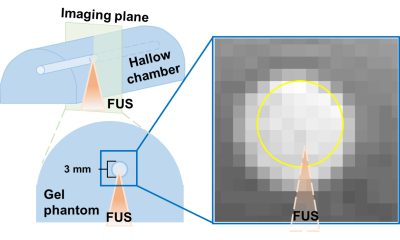 |
Evaluate Acoustic Radiation Force Induced Displacement of High Velocity Core by Phase-contrast MRI
Che-Wei Wu, Po-Hung Hsu, Hao-Li Liu, Chen-Hua Wu, Ching-Hsiang Fan, Chih-Kuang Yeh, Wen-Shiang Chen, Hsu-Hsia Peng
We hypothesized that the aggregated bubbles could be seen as a barrier, which might alter the flow pattern by shifting the high velocity core of flowing fluid. The aim was to assess the secondary acoustic radiation force and the size of aggregated bubbles, and thereby to estimate the amount of delivered drug in the targeting tissue. We found that larger displacement generally occurred with higher acoustic pressure, higher microbubble concentration, and slower flow velocity. In conclusion, we verified the feasibility of using phase-contrast MRI to evaluate the displacement of high velocity core in a phantom with flow microbubbles.
|
|
1492.
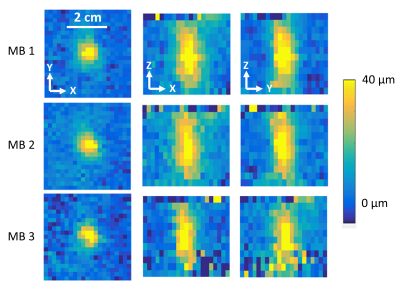 |
Volumetric and rapid MR-acoustic radiation force imaging using simultaneous multi-slice imaging
Pierre Bour, Valéry Ozenne, Stanislas Rapacchi , Marylène Delcey , Rainer Schneider, Wadie Ben Hassen, Bruno Quesson
The local tissue displacement induced by acoustic radiation force impulses (ARFI) during MR guided HIFU can be used to localize the focal spot position before thermal ablation and to monitor qualitative changes in tissue elasticity during ablation. However current MR-sequence implementations lack of spatial coverage, for a temporal resolution in the order of the timescale (<1Hz) of displacement changes during sonication. To address this limitation, we developed a simultaneous multislice MR-ARFI sequence with a slice acceleration factor up to 3. Displacement estimations measured with accelerated sequences are compared to reference values using a non-accelerated sequence.
|
|
1493.
 |
Application of hybrid MR-ultrasound imaging to multi-baseline thermometry
Pei-Hsin Wu, Cheng-Chieh Cheng, Frank Preiswerk, Bruno Madore
MR thermometry, and more specifically the proton resonance frequency (PRF) shift method, has been widely employed for monitoring temperature change. However, breathing motion tends to corrupt the image phase that PRF relies upon. An existing free-breathing method called ‘multi-baseline thermometry’ was improved here by including a small ultrasound-based sensor fixed to the abdomen of the volunteer, to further help monitor and handle breathing motion. Utilizing both morphology (as in multi-baseline thermometry) and sensor information, better estimates of temperature changes could be achieved during breathing.
|
|
1494.
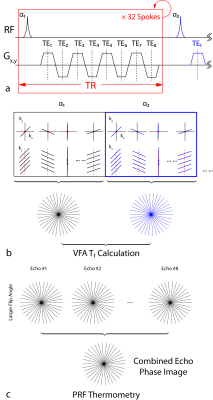 |
Hybrid Proton Resonance Frequency Shift and Variable Flip Angle T1 Temperature Mapping using a Golden-Angle 3D Stack-of-Radial Technique
Le Zhang, Tess Armstrong, Samantha Mikaiel, Alan Priester, Rory Geoghegan, Shyam Natarajan, Holden Wu
Proton resonance frequency shift (PRF) is widely used for MR temperature mapping, but is not applicable in adipose tissues. T1 measurement is an alternative MR temperature mapping method that can be applied in adipose tissues. Combined PRF-T1 mapping has been evaluated for Cartesian MRI, but there is a lack of research for non-Cartesian techniques. In this work, we propose a new multi-echo 3D stack-of-radial technique that combines PRF and variable-flip-angle T1 measurement for MR temperature mapping. Preliminary results from laser ablation in phantoms demonstrate good agreement between temperature derived from both PRF and T1 compared to readings of temperature probes.
|
|
1495.
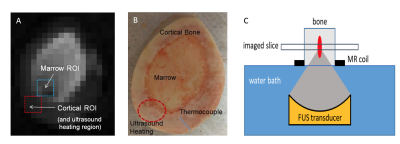 |
Detecting T1-based signal reduction in focused ultrasound heating of bone at 1.5T using a 3D spiral ultra-short echo time sequence
Helen Sporkin, Yekaterina Gilbo, Sam Fielden, John Mugler, G. Miller, Josef Pfeuffer, Berthold Kiefer, Craig Meyer
MR-guided Focused Ultrasound (MRgFUS) is used transcranially to ablate brain tissue for the treatment of essential tremor and Parkinson's disease symptoms. Proton resonance frequency shift MR thermometry detects changes in temperature in tissues with sufficiently long T2, but fails to detect heating in the cortical bone of the skull. T1-based MR thermometry uses T1 mapping to observe a linear increase in T1 with temperature but requires long acquisitions. We demonstrate a thermometry method using the linear relationship between signal magnitude from a T1-weighted 3D Spiral Ultra-short Echo Time sequence and temperature in focused ultrasound heated bone with improved temporal resolution.
|
|
1496.
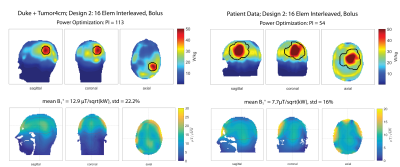 |
Radiofrequency applicator concepts for RF hyperthermia treatment and MR imaging of glioblastoma multiforme at 7.0 T (298 MHz)
Eva Oberacker, Andre Kuehne, Helmar Waiczies, Jacek Nadobny, Mirko Weihrauch, Sebastian Zschaeck, Pirus Ghadjar, Peter Wust, Thoralf Niendorf, Lukas Winter
Glioblastoma multiforme is the most frequent and most aggressive malignant brain tumor with de facto no prognosis of long-term survival by the use of current multimodal therapeutic approaches. RF heating at ultrahigh fields (B0=7.0T, f=298MHz) has the potential of delivering sufficiently large thermal dosage for hyperthermia of relatively large tumor areas. This work focuses on EMF simulations and compares RF applicator designs tailored for simultaneous RF heating and MRI. Our results suggest that RF power can be focused to small tumor areas and to large clinical target volumes derived from segmented patient data.
|
|
1497.
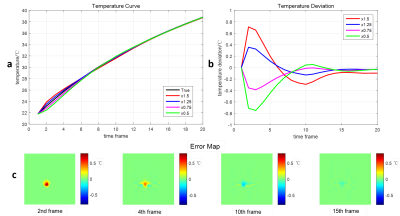 |
Bio Heat Transfer Model Based Temporally Constrained Reconstruction for Accelerated MR Temperature Imaging
Shihan Qiu, Jinchao Wu, Bingyao Chen, Jiafei Yang, Xing Wei, Kui Ying
Thermal therapies require accurate and real-time temperature monitoring to guide the treatment. To achieve higher temporal resolution in MR temperature imaging, we introduced bio heat transfer model to predict temperature maps, which are combined with previous image to act as constraints in the reconstruction of under-sampled data. An inverse optimization is also included to make the BHT model self-adaptive. Through robustness verifying experiment and heating simulation, the ability of the proposed method to provide accurate reconstruction at a high reduction factor is demonstrated in this study.
|
|
1498.
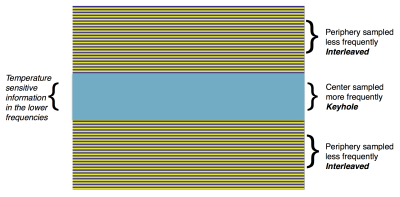 |
Accelerated MR-Thermometry Using Gradient Echo Keyhole for Focused Ultrasound
Radhika Tibrewala, Viola Rieke, Eugene Ozhinsky
MRgFUS treatments require rapid imaging to visualize the temperature and accurately determine thermal dose. We propose accelerated gradient echo keyhole trajectories for MR-thermometry, which acquire the middle of k-space densely (keyhole) while interleaving the outer k-space data. The trajectory acquisitions were synchronized to the ultrasound pulse to increase temperature accuracy. Different combinations of the keyhole size and number of interleaves were created and their accuracy was tested in a MATLAB simulation that uses the Bioheat Transfer Equation as a gold standard for temperature. The trajectories were implemented in RTHawk and results validated in a phantom experiment during focused ultrasound.
|
|
1499.
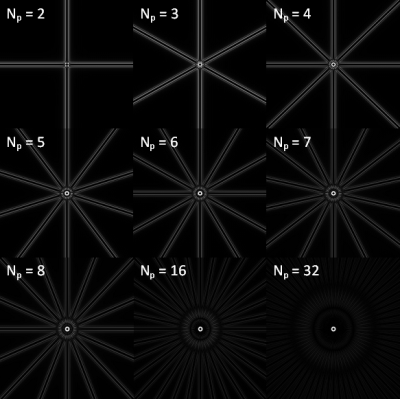 |
Passive Marker Tracking with Phase-Only Cross Correlation (POCC) in Highly Undersampled Radial Images: Improvements by Point-Spread-Function Considerations
Andreas Reichert, Michael Bock, Axel Krafft
Passive tracking with the phase-only cross correlation (POCC) algorithm can be used to accurately detect the position of MR-markers for needle procedures. The POCC tracking sequence continuously visualizes the planned needle trajectory during movement, however, image acquisition is interleaved with the measurement of two tracking images which degrades the temporal resolution. Here, it is shown that highly undersampled radial imaging together with the incorporation of the point-spread-function into the POCC algorithm can track the marker at substantially shorter acquisition times. This is an important step to improve the overall temporal resolution and might help to reduce durations of percutaneous procedures.
|
|
1500.
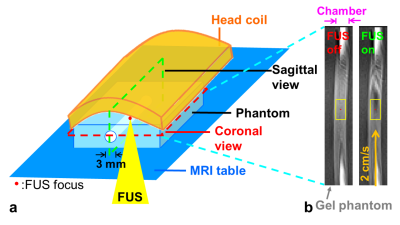 |
Mechanism of Stable Cavitation Induced Signal Intensity Changes in Fast Spin Echo Images
Cheng-Tao Ho, Chen-Hua Wu, Po-Hung Hsu, Hao-Li Liu, Chih-Kuang Yeh, Ching-Hsiang Fan, Wen-Shiang Chen, Hsu-Hsia Peng
The purpose of this study was to comprehend the mechanism of stable cavitation (SC)-induced signal intensity (SI) changes by fast spin-echo images in a phantom with flowing MBs. We postulated that the different patterns of SI changes might be related to transmitting FUS pulses at different timing of k-line acquisitions. The SC-induced microstreaming and shear force could generate hypo- and hyper-SI changes, respectively. In conclusion, the illustration of the mechanism could be helpful for designing experiments in monitoring SC-induced SI changes.
|
|
1501.
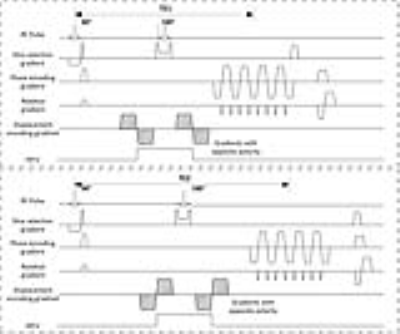 |
Simultaneous displacement and T2 mapping of High-intensity focused ultrasound therapy
Yangzi Qiao, Chao Zou, Zongwei Xu, Chuanli Cheng, Qian Wan, Changjun Tie, Xin Liu, Hairong Zheng
In this work, a hybrid ARFI sequence based on segmented SE-EPI is proposed to simultaneously monitor the displacement and T2 change of tissue during HIFU therapy. The reliability of this sequence was validated first. The quantified displacement and T2 show good consistence with the reference ARFI and SE results. The hybrid sequence was then applied before and after HIFU therapy to evaluate the treatment effects. With the occurrence of ablative lesion, T2 relaxation time decreased in the lesion center and increased in the boundary. While the displaced region (region with obvious displacement) and the maximal displacement at focus both enlarged. In general, this hybrid ARFI is a potentially useful HIFU monitoring method in clinical application.
|
|
1502.
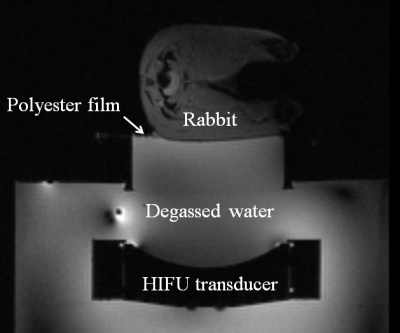 |
Monitoring of Acute Thermal Coagulation in Muscle Using PSIF Sequence in MRI-Guided High-Intensity Focused Ultrasound Therapy
Changjun Tie, Chao Zou, Qian Wan, Yangzi Qiao, Chuanli Cheng, Xin Liu, Hairong Zheng
MR-guided high intensity focused ultrasound (MRgHIFU) is a new noninvasive approach for thermal ablation of focal lesions with clinical applications in uterus, bone, prostate, brain, breast, and liver.Traditionally, the volume of tissue coagulation is evaluated through contrast enhanced T1-weighted images (CET1). However, there are several limitations for CET1 used for thermal lesion detection. In this study, acute thermal damage following HIFU ablation in muscle was assessed using a PSIF images. this preclinical study demonstrates that PSIF sequence offers a good T2 contrast for visualizing acute thermal damage in muscle tissue during HIFU treatment, and has an obvious advantage in acquisition time, making PSIF a suitable sequence for real-time monitoring tissue changes during thermotherapy at high field system.
|
|
1503.
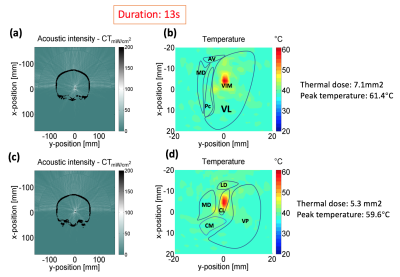 |
Feasibility Study for Off-Center Targets using ExAblate transcranial MR Guided Focused Ultrasound (tMRgFUS) System
Sijia Guo, Jiachen Zhuo, Rao Gullapalli
Recent approval by the FDA for treating essential tremors has created increased interest in targeting other critical regions within the brain. Relatively low frequency 220kHz tMRgFUS system has the potential to reach off-center targets compared to the 670kHz system used for essential tremor treatment. In this work, we assess the feasibility of the 220kHz reaching targets such as the central lateral thalamus (CL) due to its role in neuropathic pain and the more laterally located temporal lope for the role it plays in temporal lobe epilepsy. Results suggest that temporal lobe interventions are possible but may require a careful optimization.
|
|
1504.
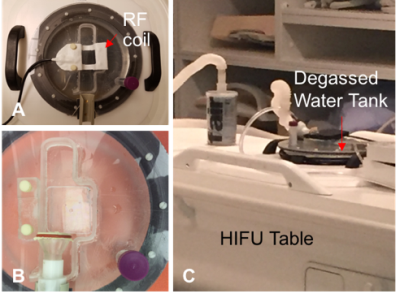 |
MR-HIFU setup for preclinical treatment of a mouse model of pancreatic ductal adenocarcinoma
Joshua Park, Ravneet Vohra, Mark Mathis, Ari Partanen, Cecil Hayes, Yak-Nam Wang, Stella Whang, Joo Ha Hwang, Donghoon Lee
Preclinical studies using animal disease models on clinical MR-HIFU systems are important for human clinical translations but are often very challenging. We developed and tested a set of hardware components to treat a transgenic mouse model of pancreatic ductal adenocarcinoma on our clinical MR-HIFU system. The hardware components include an optimized RF coil, filter, RF switches and coil/animal holder. A gel phantom and a fixed mouse body were sonicated using the developed devices and a mild hyperthermia protocol on a 3T MR-HIFU system. Pulse sequences for multi-parametric MRI were also tested to acquire optimum signal-to-noise ratio on the samples.
|
|
1505.
 |
Intra-operative MRI with MR detectable endoscope using tunable lens filled with MR contrast agent
Je-Seok Ham, Sang-In Bae, Won-Joon Do, Ki-Hun Jeong, Sung-Hong Park
During brain surgery, location of lesions can change in real-time due to leakage of cerebrospinal fluid. Therefore, navigating an MR-Endoscope probe with real-time intraoperative MRI is important in clinical application. However, conventional tracking system attached to the endoscope probe induces severe artifacts and is expensive and bulky. In this study, we propose a technique for navigating the endoscope probe without additional tracking system through segmentation of signals from tunable lens filled with gadolinium contrast agents. We also demonstrated tunable liquid-filled lens endoscope for intraoperative MRI. The proposed system/approach would be a good alternative as a tracking system for intraoperative MRI.
|
|
1506.
 |
Improved MR thermometry for laser-induced thermal therapy – tradeoffs between imaging approaches
Henrik Odéen, Dennis Parker
MR thermometry is often used to monitor thermal therapies such as focused ultrasound and laser induced thermal therapies (LITT). As in MRI in general, there is an inherent tradeoff between measurement accuracy, precision, and spatial and temporal resolution in MR thermometry. In this work we present improved acquisition protocols for 2D and 3D MR thermometry for LITT applications. We investigate and compare image quality and temperature precision for 8 different 2D and 3D GRE, and 3D segmented EPI protocols. Experiments are performed in a healthy volunteer (non-heating) and tissue-mimicking gel (with heating).
|
|
1507.
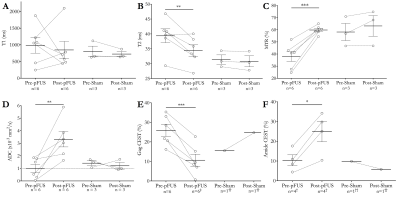 |
MRI biomarkers for focused-ultrasound treatment of pancreatic ductal adenocarcinoma
Ezekiel Maloney, Ravneet Vohra, Yak-Nam Wang, Tatiana Khokhlova, Stella Whang, Kayla Gravelle, Joshua Park, JooHa Hwang, Donghoon Lee
Pancreatic cancer is a devastating disease with poor prognosis. Pancreatic tumor therapy has been ineffective in part because pancreatic tumors have high interstitial fluid pressure (IFP), driven by high hyaluronan concentration and a dense desmoplastic stroma that inhibit penetration of drugs into the tumor. We performed multi-parametric MRI at high resolution to non-invasively assess tumor response in a KPC mouse model to pulsed focused ultrasound treatments. T1 and T2 relaxation as well as diffusion, magnetization transfer, and chemical exchange saturation transfer methods were used to characterize the tumors before and after focused ultrasound treatment.
|
|
1508.
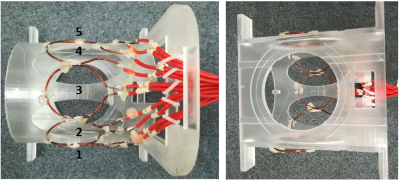 |
Performance evaluation of a B0-shim multi-coil system for small animal temperature mapping at 3T
Qiaoyan Chen, Jo Lee, Jianghong Wen, Chao Zou, Xiaoliang Zhang, Xin Liu, Ye Li
The magnetic field variation is a critical factor affecting the accuracy of temperature measurement in MRT. In this study, a 5-channel B0-shim coil was constructed for small animal temperature mapping in the MRI guided high intensity focused ultrasound (HIFU) at 3T. Firstly, the shimming ability was evaluated by the phantom study with a result that the standard deviation (STD) value of the offset magnetic field has reduced to 69% after currents optimized. Secondly, the relationship between T2* and SNR improvement has been studied. The results demonstrate that the temperature measurement accuracy is improved by 8% with the local multiple B0-shim coils.
|
|

































